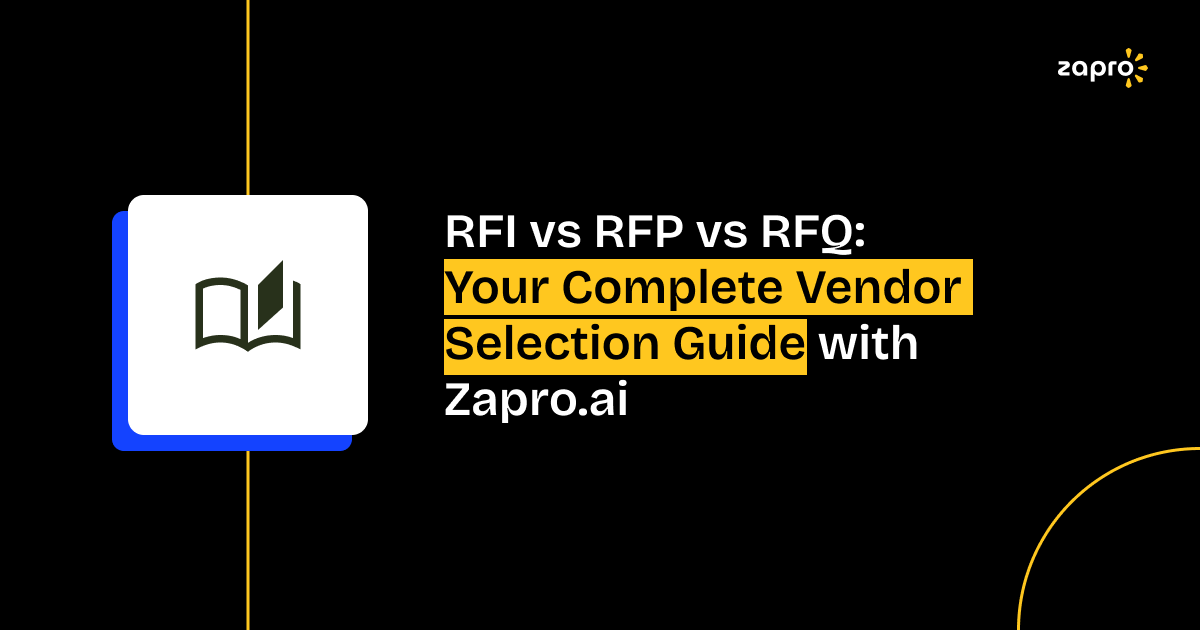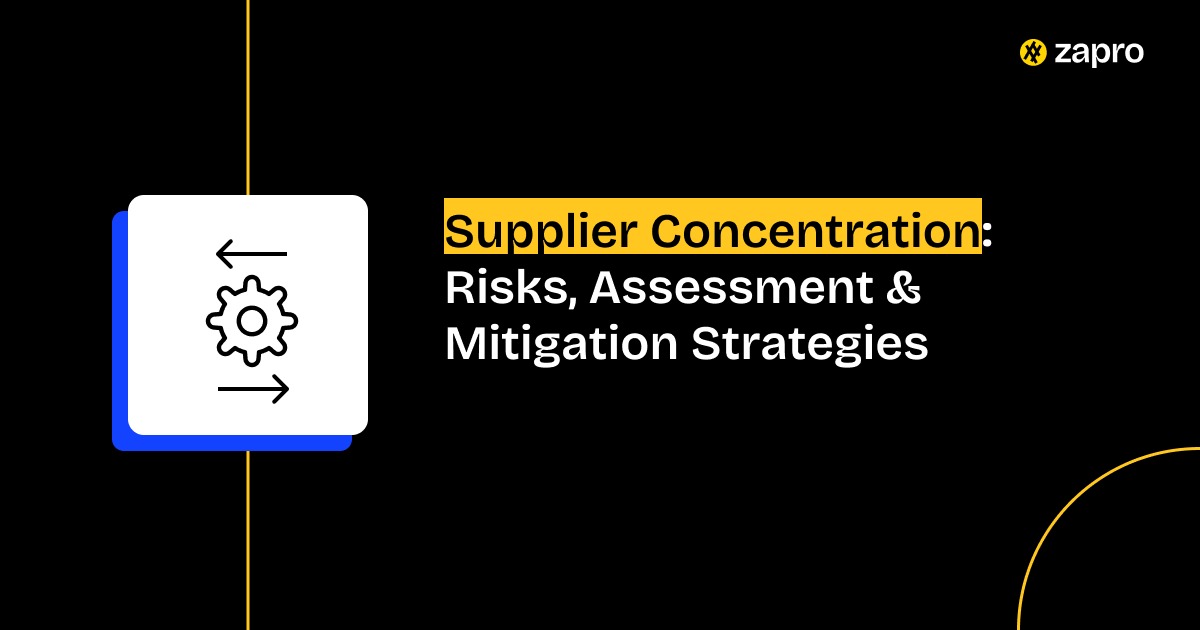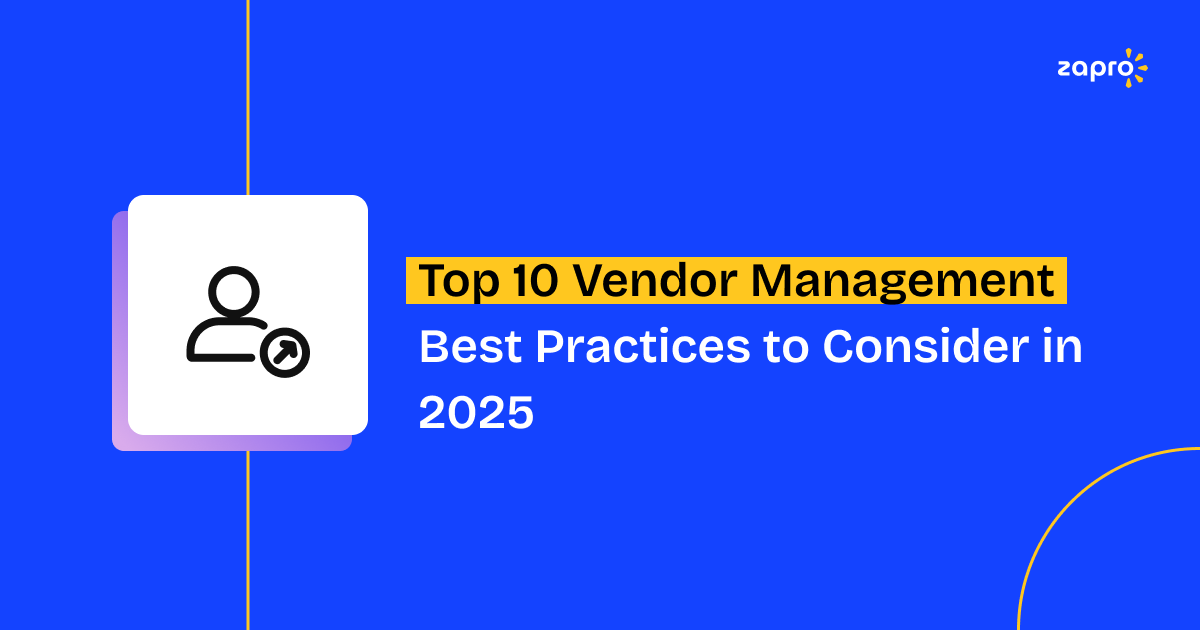You are Here: Vendor Management Portal Software >> RFI vs RFP vs RFQ
Choosing the right vendor to address all your challenges is no easy endeavor, as it can make or break a project. The quality of your suppliers directly depends on how well your vendor qualification process is organized and executed.
The smart and effective way to identify the best vendor is to start by generating a list of potential suppliers. Next, shortlist the top five, and finally, zero in on the one that best fits your needs.
This process relies on three powerful documents:
- Request for Information (RFI)
- Request for Proposal (RFP)
- Request for Quotation (RFQ)
As mentioned above, these three separate documents each serve a unique purpose to ensure you select the right supplier at the right price, without unnecessary hassle. The Zapro.ai platform streamlines this process by applying all three in sequence and managing them efficiently, enabling a seamless, data-driven path to supplier success.
RFI vs RFP vs RFQ: The Key Differences
| RFI | RFP | RFQ | |
| Purpose | Request general information on your problem and possible solutions. | Understand how a supplier plans to deliver the solution. | Get clear pricing for your chosen solution. |
| Style | Informal, exploratory, focused on opening dialogue. | Formal, detailed, requesting actionable plans. | Structured, specific, outlining exact needs for accurate quotes. |
| Advantage | Builds relationships early in the process. | Reveals the best problem-solving approach from each vendor. | Gives real-world cost clarity before signing contracts. |
What is a Request for Information (RFI)?
In the vendor selection process, the Request for Information (RFI) plays a crucial role as it helps gather information required for the mission. It helps begin with the conversation as the first step to comprehending the market, leading to asking for a specific solution or price.
In simple terms, Request for Information (RFI) works as an icebreaker to gather the needed information on how to address the issue, how different vendors management are approaching it differently, and what solutions they have to offer for you. It’s also a great way to discover their relevant experience from previous, similar cases.
Awareness Stage
In the awareness stage, the problem is well understood; however, the best solution to address the problem is not known yet. The problem is evident, for example, your supply chain is inefficient. However, the precise approach to solving this problem is still unclear. You’re in the awareness stage, and the RFI is your tool for discovery.
Intent
The core intent of an RFI is to understand the problem completely. You get to try different approaches, find out underlying factors that lie hidden, and comprehend what the vendor has to offer to solve the issue. An RFI is not the decision stage; it is a stage of getting to the bottom of the issue. It helps you comprehend and explore the market before you sign up for something beneficial.

A team using Responsive (formerly RFPIO) decreased time spent on RFPs by 49%, while increasing the invite-to-finalist rate by 25%.
RFI Components
A well-structured RFI provides valuable information from all sources consistently. It should include:
A clear table of contents for easy navigation.
- An introduction describing the problem in detail and your desired outcomes.
- A scope breakdown to guide vendor responses and keep them on topic.
- A glossary of RFI abbreviations and terms.
- A response template.
- A vendor selection process outline and a timeline for next steps.
Style
Rapport building is the approach, and there is no style to be followed as it serves as the first point of dialogue. You are committing to anything at this stage, so you are asking all the right questions to learn about the solution or service. This acts as a stepping stone to build deeper engagement in the later stage.
Advantage
Introduce and start the dialogue; this is the main advantage of an RFI. It helps you come across a lot of vendors and learn about their services and solutions without discussing the pricing. It also allows your team to accumulate a more precise perspective on the issue, enabling you to refine your requirements for subsequent steps.
What is a Request for Quotation (RFQ)?
A Request for Quotation (RFQ) allows you to connect with shortlisted vendors to obtain detailed and comparable cost estimates for a distinctly defined product or service requirement. Unlike the exploratory nature of an RFI, an RFQ is about accuracy, design, and pricing clarity.
At this stage, the organization that intends to buy understands what it wants, how it’s to be delivered, within what timeframe, and of what quality standards. The organization is eager to learn how suppliers price the requirement.
Awareness Stage
By the time an RFQ is issued, the procuring organization is no longer exploring possible solutions. The problem is well understood, the preferred solution is identified, and the technical or functional specifications are finalized.
This is the “price discovery” phase — the point where procurement software moves from defining needs to securing competitive offers.
Intent
The intent behind an RFQ is to compare and contrast the financial proposals from the shortlisted suppliers.
Here is what the vendors learn from a RFQ:
The organization tells what is needed, how much is needed, when it is needed, within what timeframe, and where to be delivered, alongside the payment terms.
With this, the procurement teams will be able to conclude on what is spent, what is received in return, its value, negotiate effectively, and pick a supplier that balances cost competitiveness with quality and reliability.
RFQ Components
A strong RFQ should leave no room for ambiguity. Common inclusions are:
Itemized Product or Service List: Clear descriptions, Technical specifications, and Service descriptions.
Required Quantities: Accurate numbers pertaining to units of measure.
Delivery Deadlines: Delivery phases and timeline.
Pricing Structure: Cost calculations, discounts, and breakups.
Payment Terms: Payment timelines, advance payment requirements, and milestones.
Compliance or Certification Requirements: Any industry-specific standards vendors must meet.
Style
RFQs (Requests for Quotation) are insightful, comprehensive documents that focus on important information without unnecessary details. They are designed for efficiency — to give suppliers the exact details they need to provide accurate, like-for-like quotes.
Because pricing is the focus, every line item should be clear enough to avoid follow-up clarification calls that delay the process.
Advantage
The RFQ process:
- Provides financial transparency by allowing side-by-side cost comparisons between similar solutions or services.
- Accelerates vendor evaluation by removing uncertainty about specifications.
- Displays a precise description for justifying the budget.
- Enhances your negotiation ability by allowing you to compare offers against one another in real time.
What is a Request for Proposal (RFP)?
A Request for Proposal (RFP) requests that your potential vendors send in a solution to address the issue in detail. The RFP is an earnest request to prove your vendor’s worth to proceed further. It is for them to come forward and explain how well they are the key to your solution. This is where vendors showcase their expertise, innovation, and understanding of your needs.
Intent
An RFP intends to identify the right vendors by comparing them based on their methodology, suitability, cost, and value. The comprehensive research is completed in RFI, and now it is the stage to see their vision. The RFP would bring to light the understanding of your shortlisted vendors of your business and the suggestions that they make to provide the proper solution or service.
RFP Components
The perfect RFP is formal, transparent, and leaves no room for puzzling. It typically includes:
- An explicit expression of your specific pain points and anticipated business results.
- Exact details on your existing procedures and functions so vendors comprehend what they’re working with.
- A complete list of requirements for the proposed solution or service.
- Compliance guidelines, evaluation criteria, and submission procedures.
- A timeline for the entire selection process.
Style
The Request for Proposal (RFP) is more professional and follows an elaborate and evaluative style. It is a formal request and does not initiate a dialogue; pitch is the essence of RFP. Therefore, the style is maintained transparently for comparing and contrasting with other proposals.
Advantage
The main advantage of an RFP is that it enables you to find the right-fit vendors based on their capacity, knowledge, and proficiency to deliver results that align flawlessly with your business requirements. By reviewing proposals, you can evaluate a vendor’s expertise, their suggested solutions or service, and their implementation plan. This approach helps you zero in on the right partner who is capable of delivering the right fit that guarantees a successful outcome.
Why These Three Requests Matter — Especially with Zapro.ai
When managed manually, RFIs, RFPs, and RFQs can turn into a messy, time-consuming paper chase. But with Zapro.ai’s procurement automation, you can:
- Digitize and centralize all request documents in one secure platform
- Create standardized templates for RFIs, RFPs, and RFQs
- Automate vendor scoring and shortlisting
- Track response times and completion rates
- Create assessments to evaluate which vendors have maintained a strong performance over time.
The process is streamlined from proposal submission to pricing evaluation and therefore, automated, ensuring no time is wasted and no opportunities are missed.
Connecting The Dots: The Vendor Selection Flow
- Start with an RFI to explore solutions and discover potential suppliers.
- Issue an RFP to shortlisted vendors to see their detailed approach.
- Ask finalists to submit an RFQ so that you can assess the total expenses.
- Choose the vendor that has the optimal blend of price, capability, and value.
Conclusion
As previously mentioned, the RFI, RFP, and RFQ process is not simply a collection of documents but rather a methodical process by which organizations generate informed decisions. By approaching these as distinct, yet interrelated steps, you move beyond basic price comparisons to conducting a full vendor assessment that considers capabilities, culture, and long-term value.
The key benefits of this approach help:
- Find the best suppliers: Discover which vendors actually have a deep understanding of your specific challenges and can provide new solutions.
- Manage risk: Carefully check-out potential vendors for compliance, soundness, and a trustworthy partnership.
- Spend Optimization: Allocate your spend most effectively and in accordance with the strategic priorities of your business.
With the Zapro.ai platform put in action, your organization would easily run the complete process, and easily transform procurement from a normal administrative function into a proactive strategic powerhouse. Unify and view all communications, automate tedious tasks, and make informed decisions by building a transparent, auditable data record.
Zapro.ai would help your team minimize risk and demonstrate a clear, measurable impact on the business’s bottom line, and secure the best possible value.
Frequently Asked Questions (FAQs)
1.Can I skip any of these steps?
No, the process should not be skipped.
The RFI or RFP process should not be skipped because it provides essential information about vendor capabilities which helps you select a partner that will meet your long-term needs. A structured process allows you to make an informed strategic decision.
2. How does Zapro.ai simplify RFI, RFP, and RFQ management?
Zapro.ai simplifies these processes by providing a centralized platform for all vendor communication and documentation. The system performs administrative work automatically which includes request distribution and response tracking. The platform includes built-in tools that enable side-by-side comparison and objective scoring to speed up vendor evaluation while increasing transparency.
3. Is this process relevant for small businesses?
Yes, the structured process applies to businesses at every level of size. Small teams can use this process to make both cost-effective and strategic decisions when resources are limited. The process becomes affordable and scalable through Zapro.ai tools which provide small businesses with the same level of rigor as large enterprises.
4. How long should each stage take?
The project stage differs based on the complexity of the project and the number of vendors involved. The prolonged timelines can be provisioned with automation to minimize it drastically. The RFI can be completed in days, the more intricate RFP follows in some weeks, and by a few days, the final RFQ.
5. Can Zapro.ai integrate with my ERP?
Yes, Zapro. ai is easily integrated with a variety of leading ERP and procurement systems. This lets your data flow seamlessly across your systems, starting with vendor onboarding and going all the way through POs to payments. Integrated with minimal single points of action, the integration removes one off, reduces manual data entry and delivers a single-pane of glass view into all your procurement operations.
Don’t miss our weekly updates
We’ll email you 1-3 times per week—and never share your information.

 Healthcare
Healthcare Financial Services
Financial Services Technology
Technology Venture Capitalist
Venture Capitalist Chief Procurement Officer
Chief Procurement Officer Chief Financial Officer
Chief Financial Officer





